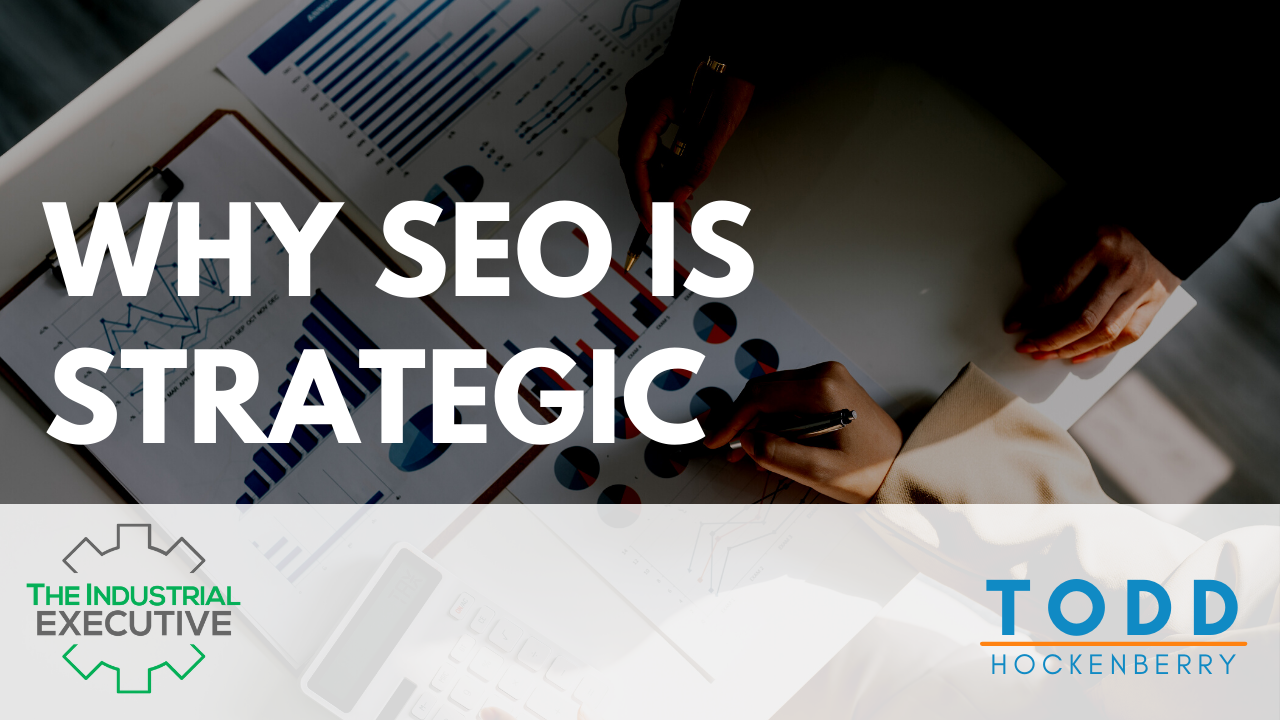Posted by Todd Hockenberry ● Aug 02, 2022
Why SEO is strategic
In the previous two articles about SEO and why it is a strategic priority for manufacturing companies, I shared these key ideas:

- SEO forces a customer-first perspective and pushes leaders to understand the impact of customer experience on growth - focusing your attention on your best prospects drives long-term revenue
- SEO requires you to think about whom you help and how you help them forcing you to focus and understand your buyer and their expectations - Understanding how your best prospects view their issues and opportunities and being there 24/7 for them drives long-term revenue.
- SEO forces you to think about changing tools, technology, and search options from your customer’s point of view - Making it easy to connect and converse with your best prospects to drive long-term revenue.
- SEO requires constant effort and, when done correctly, builds long-term enterprise value - Building a culture that values SEO over time consistently drives long-term revenue.
But wait, there’s more!
SEO keeps your brand credible
A well-executed SEO strategy also keeps your brand fresh, relevant, and credible with your target audience.
Your website is the new reception room for your business, and this is where you will make your first impressions with prospects, partners, and potential employees.
Your brand is what they think it is, not what your marketing agency says or your CEO thinks it is. Your website is your brand, and if you have a bad website, then you leave a bad brand impression.
By staying current with the current optimization best practices, you communicate to your audience that you care about their experience with your site. People will assume you will extend the same helpful attitude they see on your website to future interactions.
Engagement changes rapidly, and people expect more and more from websites. If your site is the same over a long period of time, you will probably stagnate in organic rankings and leave the impression that you do not care to update your user experience constantly.
The first company to be helpful has a much higher chance of earning the customer.
By showing up at the top of key industry searches, you inherently build credibility for your brand across all stakeholder types.
SEO requires constant competitive analysis
During a recent SEO competitor audit with one of our clients, we discovered that the competitor was rapidly rising in the ranking of a set of niche keywords. Digging deeper into the data, we discovered that the company was making a major investment in equipment, product, distribution, and sales to enter this niche market.
One that our client also wanted to enter.
SEO research gave our clients the opportunity to respond much faster than if they had waited to see the competitor in the field. We think we gave our client at least 6 months more to respond in kind than without the benefit of the SEO insights.
You can copy your competitors with SEO research, or you can learn from them and adjust your unique strategy in turn. Just trying to emulate your competitors rarely works but learning from them and finding their weak and strong areas gives you an opportunity to carve out your unique position in the market.
SEO Should Reflect Your Culture
The ideas expressed on your website should be reflected throughout your organization.
"The first and most important step is to shift the organization’s mindset to focus on solving for the customer. Make decisions based on what’s in their interest—because what’s in the customer’s interest is in the organization’s interest too." Dharmesh Shah, HubSpot, Inbound Organization, Wiley 2018.
Culture is the sum of the values, attitudes, beliefs, and behaviors of leadership applied through an operating system. Your operating system is the set of tools and processes your business develops to guide your team toward the mission.
The operating system includes communication systems and tools, employee feedback mechanisms, your documented culture, and connections for each employee to the company strategies and plans and how they contribute to the overall business objectives.
A customer-focused culture drives alignment to the mission and aligns everyone with the goals of the customer. The operating system enables your people to deliver value to the customer and to contribute feedback to the team and leadership.
SEO is a key part of an Inbound Organization’s operating system and culture. SEO is a way to understand what customers want and then give it to them. If you care about customers as a way to build the enterprise value of your business, you will make SEO a strategic effort that resonates throughout your entire business.
You can check out the previous articles in this series here:
If you would like to talk about your SEO, I would love to listen! We will also provide a free review with actionable steps to improve your SEO.
Topics: SEO





